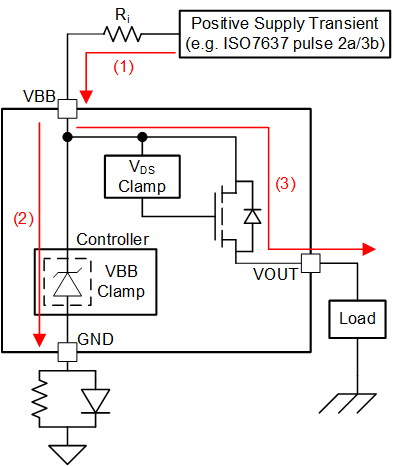JAJSGO4D November 2018 – December 2019 TPS1HA08-Q1
PRODUCTION DATA.
- 1 特長
- 2 アプリケーション
- 3 概要
- 4 改訂履歴
- 5 Device Comparison Table
- 6 Pin Configuration and Functions
- 7 Specifications
- 8 Parameter Measurement Information
-
9 Detailed Description
- 9.1 Overview
- 9.2 Functional Block Diagram
- 9.3
Feature Description
- 9.3.1 Protection Mechanisms
- 9.3.2 Diagnostic Mechanisms
- 9.3.3 Enable Watchdog
- 9.4 Device Functional Modes
- 10Application and Implementation
- 11Power Supply Recommendations
- 12Layout
- 13デバイスおよびドキュメントのサポート
- 14メカニカル、パッケージ、および注文情報
パッケージ・オプション
メカニカル・データ(パッケージ|ピン)
- PWP|16
サーマルパッド・メカニカル・データ
- PWP|16
発注情報
9.3.1.4 Voltage Transients
The contains two voltage clamps which protect the device against system-level voltage transients.
The clamp from VBB to GND is primarily used to protect the controller from positive transients on the supply line (for example, ISO7637-2). The clamp from VBB to VOUT is primarily used to limit the voltage across the FET when switching off an inductive load. Both clamp levels are set to protect the device during these fault conditions. If the voltage potential from VBB to GND exceeds the VBB clamp level, the clamp will allow current to flow through the device from VBB to GND (Path 2). If the voltage potential from VBB to VOUT exceeds VCLAMP, the power FET will allow current to flow from VBB to VOUT (Path 3).
 Figure 39. Current Path During Supply Voltage Transient
Figure 39. Current Path During Supply Voltage Transient